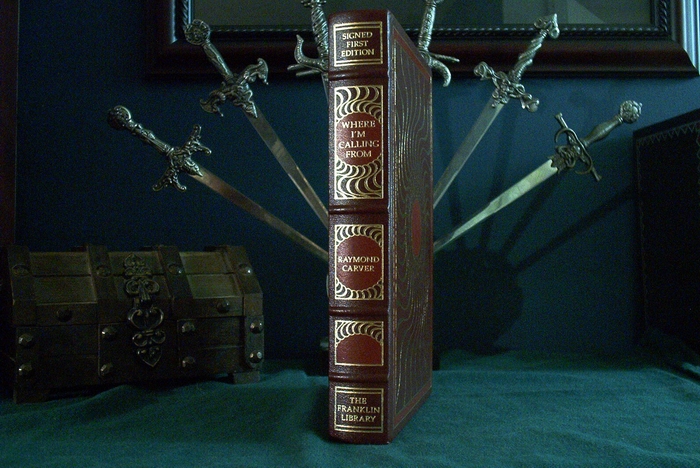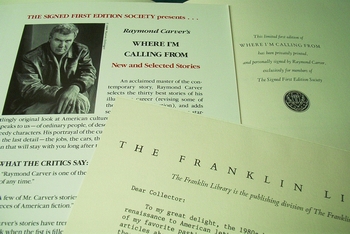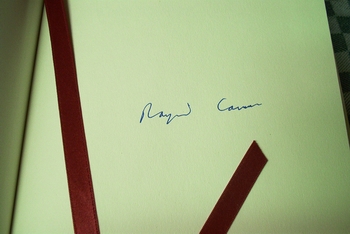Franklin Library Raymond Carver books
Where I'm Calling From - signed first edition - 1988
Writer Raymond Carver
Raymond Carver, a renowned American short story writer and poet, was born on May 25, 1938, in Clatskanie, Oregon. He emerged as a prominent literary figure in the latter half of the 20th century, known for his minimalist style and profound exploration of the lives of ordinary people. Carver's early life was marked by financial struggles and personal challenges. Growing up in a working-class family, he experienced poverty and witnessed the impact of his father's alcoholism. Despite these difficulties, Carver developed a passion for literature and attended various colleges, including Chico State College and Humboldt State College, though he did not complete a degree. In 1957, Carver married his first wife, Maryann Burk, and they had two children together. Over the years, Carver battled with alcoholism, a struggle that would significantly influence his work and personal relationships. His first collection of poems, Near Klamath, was published in 1968, but it wasn't until the 1970s that he gained wider recognition for his short stories.
Carver's breakthrough came with the publication of his collection Will You Please Be Quiet, Please? in 1976. This marked the beginning of his exploration of the lives of ordinary people in the American working class, capturing the complexities of relationships, often marked by dysfunction and disillusionment. His stories were characterized by a spare, minimalist prose style, a hallmark of the literary movement known as "dirty realism." Throughout the late 1970s and 1980s, Carver continued to publish acclaimed works, including What We Talk About When We Talk About Love (1981) and Cathedral (1983). The latter is considered one of his masterpieces and showcases his ability to illuminate the profound moments of human connection amid the struggles of everyday life.
Cathedral is one of Raymond Carver's most well-known and frequently anthologized short stories. It was first published in 1981 as the title story in the collection Cathedral. The narrative is a poignant exploration of human connection and understanding, delving into themes of perception, communication, and the potential for transformation. The story is narrated by an unnamed man who is somewhat limited in his ability to empathize and understand others. He is married to a woman who has a close friend, a blind man named Robert, whom she met years ago when she worked for him as a reader. After the death of Robert's wife, the narrator's wife maintains a correspondence with him. The central event of the story occurs when Robert decides to visit the narrator's home. The narrator feels uncomfortable and uneasy about the impending visit. His discomfort stems from his prejudice and lack of understanding about blindness. As the story progresses, it becomes evident that the narrator's limitations are not only related to his perception of blindness but also extend to his emotional and spiritual understanding. The turning point in the story comes when the characters engage in an unusual activity: they draw a cathedral together. The blind man, Robert, places his hand on the narrator's as they draw, and the narrator starts to gain a deeper understanding of the blind man's world. The act of drawing the cathedral becomes a metaphor for a shared human experience, transcending the limitations of sight. By the end of the story, a subtle but powerful transformation occurs within the narrator. Through the shared experience of drawing the cathedral, he begins to see beyond his prejudices and limited perspective. The story suggests that true understanding and connection come from empathy, communication, and a willingness to open oneself to different ways of experiencing the world. Cathedral is celebrated for its exploration of the complexity of human relationships and the potential for personal growth and transformation. Carver's minimalist prose style is evident in the spare and economical language he uses to convey the emotional depth of the characters and the narrative. The story is often considered a masterpiece of contemporary American short fiction and remains a staple in literature courses and anthologies.
Carver's personal life underwent significant changes in the 1980s. He divorced Maryann and remarried poet Tess Gallagher in 1988. This period also saw a positive shift in his battle with alcoholism, as he embraced sobriety and a more stable family life. Tragically, Raymond Carver's life was cut short when he succumbed to lung cancer on August 2, 1988, at the age of 50. Despite his relatively brief career, Carver left an indelible mark on American literature. His work has continued to influence subsequent generations of writers, and his legacy as a master of the short story genre endures. Posthumously, some of his unfinished work was edited and published by Gallagher, further contributing to his lasting impact on the literary world.
Where I'm Calling From - New and Selected Stories
By the time of his early death in 1988, Raymond Carver had established himself as one of the greatest practitioners of the American short story, a writer who had not only found his own voice but imprinted it in the imaginations of thousands of readers.'Where I'm Calling From', his last collection, encompasses classic stories from 'Cathedral', 'What We Talk About When We Talk About Love' and earlier Carver volumes, along with seven new works previously unpublished in book form.
Together, these 37 stories give us a superb overview of Carver's life work and show us why he was so widely imitated but never equalled.




Comments
Post a Comment
Share your best book review and recommendation